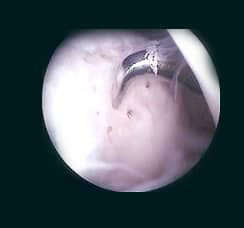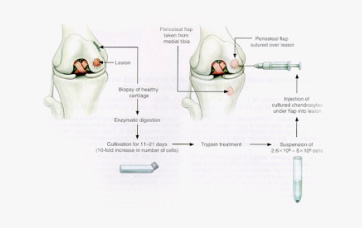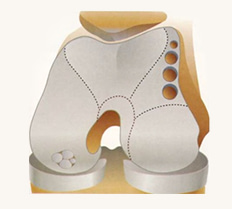Cartilage Replacement Surgery of the Knee – Microfracture, ACI, OATS, Osteochondral Allograft, and Denovo NT
BIOLOGICAL SURGICAL REPAIRS FOR THE INJURED KNEE
The ideal treatment for any knee injury or disease is a biologic treatment that can restore the knee to a near normal state. Anterior Cruciate Ligament reconstruction, meniscal repair, and anatomic repair of fractures of the knee are three examples of successful biological surgical repairs for the injured knee.
Symptomatic full thickness chondral lesions of the knee pose a difficult management issue for both orthopedists and patients. If injury leads to articular cartilage cell death the best treatment is restoration of the joint surface cells (articular cartilage-the shiny white surface that forms all joints in the body). There are four distinct options for treatment: Microfracture, ACI (Autologous Chondrocyte Implantation), OATS (osteoarticular transfer system) and Osteochondral Allograft.
Smaller lesions in younger patients can do well with Microfracture surgery, in which a pick like tool is used to create multiple entries into the marrow of the knee under the chondral defect and this so called marrow stimulation can cause repair tissue to form and fill in the chondral defect with fibrous cartilage repair tissue. A patient is on crutches for 1 ½ – 2 months, is out of sports for 6-12 months and may take 1 ½ years for total pain relief (What is a microfracture?).


One procedure to restore the knee surface to near normal is termed ACI or autologous chondrocyte implantation. This procedure can be used to cover large defects of the knee. This procedure uses articular cartilage cells harvested from the healthy part of an injured knee. Cartilage replacement is a procedure that has strict use criteria, or indications. The surgical indication for ACI is a symptomatic, full thickness, weight bearing chondral injury of the femoral articular surface in a physiologically young patient who can be compliant with the 18 month long rehabilitation process. The results of ACI surgery for lesions on the tibia and patella are not as consistently successful and use for this part of the knee is not usually paid for by insurance companies. Also, ACI is not a treatment for Osteoarthritis (two reciprocal joint surfaces are damaged with x-ray changes of joint space narrowing, and bone spur formation). 3T MRI can be helpful with assessing knees for ACI but in almost all circumstance a knee arthroscopy is performed to be sure the knee is suitable for ACI.
At the time of Diagnostic Knee Arthroscopy the articular cartilage cells are harvested for reimplantation at a later date (after cell expansion in the lab at Genzyme Biosurgery). This knee cartilage replacement technique requires two operations (arthroscopic harvest of cells and open knee surgery to implant cells). The perceived advantage of knee cartilage replacement is that this method regenerates cells that are very similar to normal cartilage tissue. A second benefit is that no cadaver donor is used (Osteochondral Allograft uses cadaver donor). After surgery the patient must be 8 weeks on crutches, 6-18 months for pain relief and 12 months or longer for full return to activities. More details are found at the following link: Treatment with CARTICEL®.

OATS procedure (osteoarticular transfer system) restores the chondral surface by transplanting multiple healthy cores of articular cartilage and bone from a healthy perimeter area of the knee into the damaged area. This is done if the lesion is 1cm- 2 cm in diameter. This is done with one operation using arthroscopy and a small incision. Down time is the shortest for this procedure with a month or 6 weeks on crutches and return to activities in 3-6 months. Pain relief is seen in 2-4 months (OATS Procedure).
For large lesions the alternative to ACI is Osteochondral Allograft. A fresh cadaver donor femur with living articular cartilage cells is used to procure a size matched graft. This tissue is not released until at least 21 days after harvest so the donor’s safety can be assessed (free from harmful disease like hepatitis, HIV and bacteria). A large core with articular cartilage and bone are taken from the donor at the time of surgery and placed into an identically sized recipient core in the injured knee. Osteochondral Allograft is a one surgery process (ACI is two surgeries). This is an open knee surgery. Crutch time is 3-6 months to protect the large graft as it heals. Return to normal activities is one year. The donor tissue does not always incorporate and become living tissue. Success rate is 75% for good long term results.

DENOVO NT GRAFT – ADVANCING THE SCIENCE OF CARTILAGE REPAIR
DeNovo NT Natural Tissue Graft is a juvenile cartilaginous allograft tissue intended to provide surgeons with an early intervention option for the repair of articular cartilage in anatomic focal cartilage defects. It offers a single-stage procedure with fibrin fixation that eliminates the need for harvesting a periosteal flap. Zimmer introduced DeNovo NT Graft over four years ago. There is one published peer reviewed journal articles (as of May, 2014) validating this method. However, the product is being used across the US with the early results promising for relieve of pain due to isolated articular cartilage defects (joint surface injury).
The most common indication is for contained, isolated defects on the femoral trochlea or medial femoral condyle. Although investigational, this technique may be one of the only options to treat an isolated, full thickness tibial or patellar cartilage defect. We have had successful “insurance pre approval” for this procedure. The Zimmer Access to Care program does improve our success with insurers. DeNovo NT is an alternative to the other cartilage restoration methods detailed on this page.

WATCH RELATED VIDEOS
Makoplasty Robotic Assisted Knee Surgery Videos
Ready to Schedule a Consultation?
Get started today by completing our request form. If you have additional questions, contact us by phone or e-mail, and our trained staff will assist you to the best of our ability or have Dr. Tarlow address your question when appropriate.
